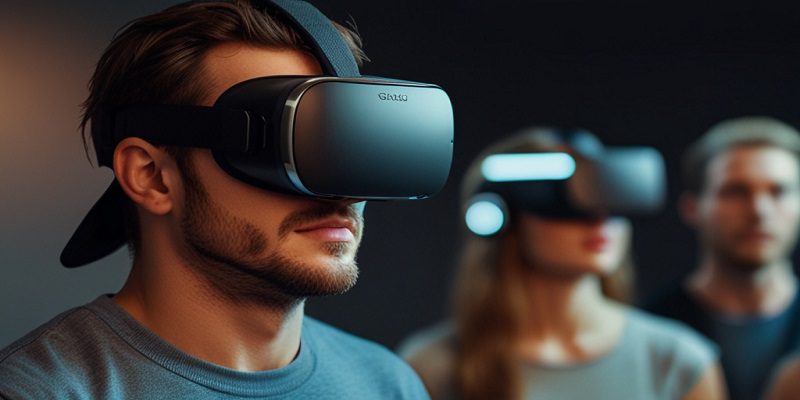Virtual Reality (VR) has undergone a dramatic transformation in recent years, evolving from a futuristic concept to a practical technology that is reshaping various aspects of our daily lives. This article explores ten significant ways VR is making an impact, highlighting its potential to revolutionize different sectors and enhance our everyday experiences.
Immersive Gaming Experiences
One of the most well-known applications of VR is in the gaming industry. VR provides an immersive gaming experience that traditional gaming platforms cannot match. Players can step into a virtual world and interact with it as if they were physically present. This level of immersion enhances the gaming experience, making it more engaging and realistic.
Enhanced Interaction and Engagement
VR games allow players to use their body movements to control their in-game avatars. This physical interaction creates a deeper connection between the player and the game, increasing engagement and enjoyment. The use of VR headsets and motion controllers further intensifies this immersive experience.
Virtual Travel and Tourism
VR is revolutionizing the travel and tourism industry by offering virtual tours of destinations worldwide. This technology enables people to explore places they may never have the opportunity to visit in real life.
Exploring Destinations from Home
Virtual tours allow users to walk through famous landmarks, museums, and natural wonders from the comfort of their homes. This not only saves time and money but also makes travel accessible to those with physical limitations or travel restrictions.
Remote Work and Collaboration
The COVID-19 pandemic accelerated the adoption of remote work, and VR has played a significant role in enhancing remote collaboration. VR platforms provide virtual meeting rooms where colleagues can interact as if they were in the same physical space.
Virtual Meetings and Team Building
Using VR for meetings eliminates the need for physical presence, reducing travel costs and time. Additionally, VR-based team-building activities foster stronger relationships among remote team members, enhancing collaboration and productivity.
Education and Training
VR is transforming education by providing immersive learning experiences. It allows students to visualize complex concepts and interact with virtual objects, making learning more engaging and effective.
Interactive Learning Environments
In subjects like history, science, and geography, VR can take students on virtual field trips to historical sites, inside the human body, or to different geographical locations. This interactive approach makes learning more enjoyable and memorable.
Professional Training
In professional settings, VR is used for training purposes. For example, medical students can practice surgeries in a virtual environment, and pilots can simulate flights. This hands-on training is safer and often more cost-effective than traditional methods.
Healthcare and Therapy
VR has significant applications in healthcare, from patient treatment to medical training. It offers innovative solutions for therapy and rehabilitation.
Pain Management and Rehabilitation
VR is used for pain management by distracting patients during painful procedures. In rehabilitation, VR exercises help patients regain motor functions through engaging virtual activities. These applications make treatments more effective and enjoyable for patients.
Mental Health Therapy
VR is also used in mental health therapy, providing controlled environments for exposure therapy, which is used to treat conditions like PTSD and phobias. Patients can confront their fears in a safe, virtual setting, aiding their recovery process.
Retail and Shopping
The retail industry is leveraging VR to enhance the shopping experience. Virtual stores allow customers to browse products, try them on virtually, and make purchases without leaving their homes.
Virtual Try-Ons
Retailers use VR to offer virtual try-ons for clothing, accessories, and even makeup. This technology helps customers make informed decisions, reducing the likelihood of returns and increasing customer satisfaction.
Virtual Showrooms
Automobile and furniture companies use VR to create virtual showrooms. Customers can explore different models, customize features, and visualize how products will look in their spaces. This immersive experience aids in the decision-making process.
Real Estate and Property Tours
The real estate industry is benefiting from VR by offering virtual property tours. This technology allows potential buyers to explore properties remotely, saving time and effort.
Virtual Property Walkthroughs
VR property tours provide a realistic sense of space and layout, helping buyers make informed decisions. It also enables real estate agents to reach a broader audience, including international buyers who cannot visit properties in person.
Fitness and Exercise
VR is making fitness more enjoyable and accessible. Virtual fitness programs and games encourage physical activity through engaging and interactive experiences.
Gamified Workouts
VR fitness games turn exercise into a fun activity. Users can participate in virtual sports, dance routines, and adventure games that require physical movement. This gamified approach motivates people to stay active and healthy.
Personalized Fitness Programs
Fitness apps and programs use VR to create personalized workout routines. Users can have virtual trainers who guide them through exercises, providing real-time feedback and motivation.
Social Interaction and Networking
VR is changing the way we socialize and network. Virtual social platforms allow people to connect, interact, and build relationships in immersive virtual environments.
Virtual Social Spaces
Platforms like VRChat and AltspaceVR provide virtual spaces where users can meet, chat, and participate in activities together. These social spaces offer a sense of presence and connection that traditional online communication methods lack.
Networking Events and Conferences
VR is also being used for networking events and conferences. Attendees can participate in virtual events, visit virtual booths, and engage in live discussions, making networking more accessible and efficient.
Entertainment and Media
The entertainment and media industry is leveraging VR to create immersive content. From virtual concerts to 360-degree videos, VR is enhancing how we consume media.
Virtual Concerts and Events
Artists and event organizers are hosting virtual concerts, allowing fans to experience live performances from their homes. VR concerts provide a front-row experience, complete with interactive features and social interactions.
Immersive Storytelling
Filmmakers and content creators are using VR to tell stories in new and innovative ways. 360-degree videos and interactive experiences immerse viewers in the narrative, making them feel like active participants rather than passive observers.
Conclusion
Virtual Reality is no longer a futuristic concept but a transformative technology that is reshaping various aspects of our daily lives. From gaming and education to healthcare and social interaction, VR is making a significant impact across multiple sectors. As technology continues to advance, we can expect even more innovative applications of VR that will further enhance our experiences and improve our quality of life. Embracing VR and its potential can lead to a more connected,








